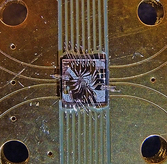What happens if you embed an ultrafast quantum computer inside a diamond (you know, aside from qualifying for sale in one of Tiffany’s catalogues and inviting “forever” computing quips)? Answer: You get a quantum computer that actually works.
The trouble with quantum computers — devices that employ quantum principles to perform functions similar to digital computers — is that their operations can easily get muddled. It’s a problem known as “quantum decoherence,” but don’t be put off by that term, because it means just what it sounds like: a tendency for a quantum computer’s functions to become less coherent as it gets influenced by the world around it.
Enter one of the world’s hardest materials, diamond, apparently capable of helping quantum computing technology grapple with disruptive decoherence, and a multinational team of scientists who’ve reportedly built an honest-to-goodness quantum computer inside one.
(MORE: Meet Intel’s Crazy 50-Core ‘Knights Corner’, World’s First 1 TFLOPS Processor)
Researchers at Ames Laboratory (a U.S. Department of Energy national lab) and Iowa State University, the University of California, Santa Barbara and the Kavli Institute of Nanoscience, Delft University of Technology in the Netherlands say they’ve managed to build a solid-state quantum computer using a diamond to perform quantum calculations in a way that’s basically protected from environmental interference (and, thus, decoherence). They add that the results may be “an important step on the road towards a future, ultrafast quantum computer.”

Delft University of Technology / UC Santa Barbara
Quantum computers work by taking quantum principles, say the state of a quantum particle like an electron, and using its inherent variability to perform calculations. But whereas in a digital computer a bit is either set to “0” or “1,” in a quantum computer, the bit can be “0” and “1” at the same time, somehow managing not to wreak havoc on the time-space continuum (but mostly just allowing for incredibly fast calculations — the principle is called “superposition”). The trouble, as noted above, is that a particle like an electron is so sensitive to its environment that it’s easily disrupted, throwing off the whole process and making the development of a large-scale quantum computer problematic.
(PHOTOS: A Brief History of the Computer)
Using a 1mm by 1 mm sized diamond chip at room temperature, researchers were able to perform a quantum calculation using what they call a “double quantum bit processor.” The two qubits, or “quantum bits,” were defined as the spin of a nitrogen nucleus and the spin of an electron, and the impurities in the diamond were actually used to isolate them. The calculation involved searching and finding an element within a database that contained four total, and here’s the key part: the quantum computer was able to come up with a result in a single attempt. Your garden variety computer today, by comparison, takes two.
The other upside, say researchers, is that this is a solid-state design, making it much easier to upscale than past attempts via liquid- or gas-based systems. According to the researchers:
This is a small-scale demonstration of the superior efficiency of a quantum computer. At the same time it is the first time a quantum algorithm has been performed using spin quantum bits on a chip.
The researchers note that two years ago, they published the results of an experiment in which they first demonstrated how the spin state of a quantum particle could be protected from decoherence using microwave pulses. But in protecting the particle’s spin state from interference, they also “decoupled” it from its environment, making it a shoe-in for storing information, but compromising its ability to perform actual computer-style calculations (quantum particles need to be able to interact).
The results of the experiment were just published in the international science journal Nature, and the research team’s next step: adding more quantum bits to the chip.

